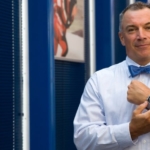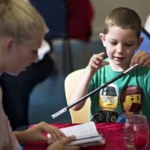Adapting national parks for wheelchair hiking
The trails through our public lands weren’t designed for wheelchairs, but new wheelchairs are designed for those trails. National Park Service accessibility specialist Quinn Brett wants parks to catch up with wheelchair technology, increasing access to American wilderness.

Quinn Brett hikes with her Bomber off-road handcycle on Walter’s Wiggles, a steep trail named for its many switchbacks, in Zion National Park. Image Courtesy of Quinn Brett
By Alissa Greenberg, PBS Nova April 12, 2022
In the parking lot of the Cub Lake trailhead on a sunny fall day in Rocky Mountain National Park, Quinn Brett maneuvers from her wheelchair onto her Bomber off-road handcycle. Using her upper body, she shifts into a kneeling position atop the tricycle’s frame, hunching forward between its two bicycle-size front tires and over its hand-powered crank to grip the handlebars and throttle.
When she’s ready, Brett rolls down the trail, which snakes through a golden alpine meadow backed by snow-glazed peaks. Reaching a bridge arching over a small river, she pauses, noticing that the first slat is a few inches higher than the trail. The bridge is wide enough, she says as she stops to look out over the burbling water, but that height difference could be a problem for someone traversing the trail in a wheelchair like the one she left in the parking lot. “It’s a half day’s work, not even,” for a trail crew to mound earth up to make a ramp. “And that then allows somebody who is in a powerchair to at least get on the bridge and see the river.” She takes a photo to mark the spot.
From here, the terrain grows rougher. Brett’s handcycle manages ably over the boulders and potholes. But, she says, “for a power chair, this would be the end.” And soon she faces the trail’s first set of stairs, dirt steps edged in wood set into a hill. She tries several different ways of climbing them, but her wheels continue to spin and crunch. The spacing of the steps doesn’t allow her handcycle to get the traction it needs.
In 1964, Congress didn’t have to consider wheelchair users when it declared in the Wilderness Act that “here shall be no temporary road, no use of motor vehicles, motorized equipment or motorboats, no landing of aircraft, no other form of mechanical transport.” The Americans with Disabilities Act (ADA) was still 25 years away. And other obstacles—rocks, steep slopes, uneven ground—made wheelchairs impossible to use in most wilderness, anyway. But that’s started to change over the past two decades. Now, people with disabilities and enough resources can choose from a fleet of custom-built devices: three wheeled or four wheeled, hand powered or motor powered, for all kinds of bodies and mobility needs. Thanks to these devices, users can travel terrain they never could before, and they’re pushing the National Park Service to rethink how people with disabilities fit into the wilderness—with Brett leading the way.
Try as she might, Brett can’t get her handcycle up the steps. “Okay, that might be it,” she finally concedes. “So what else can I do here?” There’s only one option left: go around.
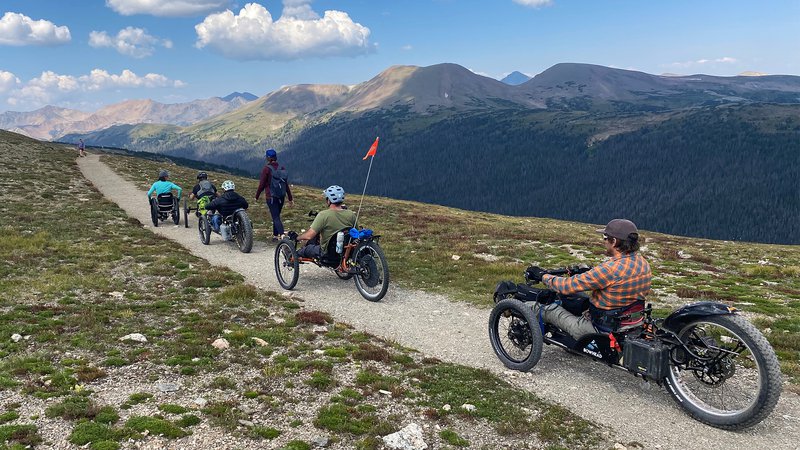
Adaptive hikers on Ute trail in Rocky Mountain National Park. Image courtesty of Quinn Brett
Brett learned from a friend about the existence of devices like her off-road handcycle in early 2018, soon after breaking her spine while climbing El Capitan in Yosemite National Park. The fall left her paralyzed from the waist down. Brett, who adored visiting public lands with her family as a kid, calls spending time outside “a necessary part of my identity.” Before her injury, she worked as a climbing ranger at Rocky Mountain National Park and rock climbed professionally as well.
The morning I meet Brett for our hike, she gives me a tour of her collection of mobility devices, which she keeps in her garage in Estes Park, Colorado, a few miles from the national park. Her two Bombers are her go-to devices for hikes, she says. She likes getting exercise with the hand crank, and the higher clearance works well on rocky terrain, though it means she’s more vulnerable to tipping. Then there’s the Bowhead Reach, also three wheeled but lower to the ground and with a full electric hand-twist throttle instead of a crank. It’s designed particularly for users like Brett’s colleague Joe Stone, an incomplete quadriplegic with limited grip function in his hands who helps run Teton Adaptive, an “adaptive outdoors” organization in Wyoming that helps athletes with disabilities get outside. Other devices on the market, she tells me, include both reinforced canes and walkers and a slew of different seated off-road vehicles with beefy tires, levering propulsion, hefty shock absorbers, and powerful brakes.
The rise of these new devices has been life-changing for people like Brett and Stone. After 11 years using a wheelchair, “this past summer I was able to really get out and explore the mountains again,” Stone says. “It was an amazing experience.” And since acquiring the Bombers and Bowhead—two through grants and one as a gift—Brett has hiked through canyons and on slick rock, gone flyfishing in Montana, climbed mountains, and scrambled through boulder fields. Last summer, she completed the Tour Divide, a 2,750-mile bicycle (in Brett’s case, handcycle) route from Banff to New Mexico that follows the crest of the Rocky Mountains, climbing a total of 200,000 vertical feet.
The handcycles have become an extension of herself on the trail, she says. She feels anxious when they’re broken and tries to schedule maintenance to line up with trips out of town. “It’s key to my wellbeing,” she says. “Like, I need to go outside.”
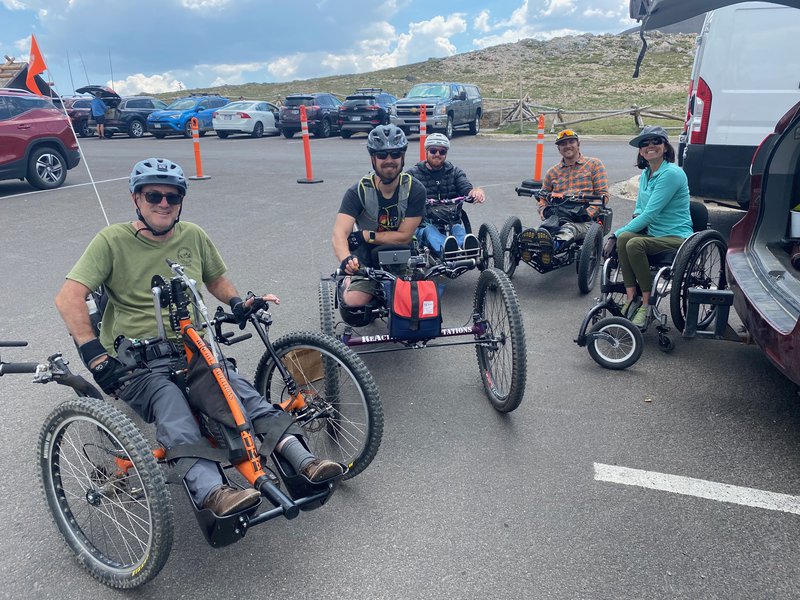
Quinn Brett (right) and fellow adaptive hikers get ready to hit the trail at Rocky Mountain National Park. Brett’s ultimate goal is for people with disabilities to visit a park without experiencing any barriers, enjoying interpretive programing as well as the backcountry, and spending time in a way that’s not segregated from other visitors. Photo courtesy of Quinn Brett
According to the Centers for Disease Control and Prevention, some 26% of the American population has a disability, roughly half of those involving mobility. The park service assumes its visitors will reflect those demographics. And since those visitors are as likely as anyone else to be traveling with friends or family, “the impact of a lack of access doesn’t just affect the experience of visitors themselves, but also the entire party they’re visiting with,” says Jeremy Buzzell, Brett’s supervisor and a manager of the park service accessibility program. “There’s a multiplier effect.” He expects that the number of visitors with disabilities will only increase as baby boomers retire and look to get outside.
Enter Brett, who rejoined the park service in July 2020 as a program analyst with a focus on backcountry accessibility.
Under the Architectural Barriers Act (ABA), a federal equivalent of the ADA, every new project within a park must meet accessibility standards. “But we have an awful lot of infrastructure that is not new: trails, campgrounds, historic buildings,” Buzzell says. So, his unit often piggybacks on improvement projects, like recent work at a viewpoint in Devil’s Tower National Monument in Wyoming, which included a fully accessible trail with tactile features for blind and low-vision visitors. But, he and Brett point out, federal lands have obligations that go beyond those fully accessible sites. “We can’t ignore the fact that there are groups of people who are going to want to get out into the wilderness, the backcountry, and some of them will have disabilities,” Buzzell says.
That’s why Brett specifically uses “hike” instead of “bike” to refer to her trail explorations. “The terminology matters,” she often says in the presentations she gives to trail managers and other park employees. Devices meeting wheelchair definitions, she points out, “are our legs for hiking.” And wheelchairs are allowed on park trails, even in wilderness.
Under the ADA, a wheelchair is “a manually operated or power-driven device designed primarily for use by an individual with a mobility disability for the main purpose of indoor, or of both indoor and outdoor, locomotion.” That includes powerful transport like the Bowhead. “Even I had a hard time wrapping my brain around it, really,” Brett says of the device hanging in her garage. “It’s fully motorized, it looks like the freaking Batmobile. You’re telling me I can take that on a trail?”
She was surprised in part because of the park service’s culture of “no wheels in the wilderness,” as she refers to it. This convention developed in response to the Wilderness Act, with its prohibition of motorized equipment and mechanical transport. The park service takes the implementation of the law seriously, agonizing over the use of hand versus power drills during projects and prohibiting its trail staff from using so much as a wheelbarrow in the wilderness.
But the ADA specifies that nothing in the Wilderness Act precludes wheelchair use in federal wilderness areas. That means the new and ever-expanding range of mobility devices available to Brett and her fellow outdoor enthusiasts are forcing new conversations about how people with disabilities fit into wild spaces. “Before, there was this idea, there’s certain trails that they’re not going to go on,” says Buzzell, certain facilities—a pit toilet at the top of a mountain, a campground at the end of a canyon trail—they’re not going to use. “This changes the conversation.”
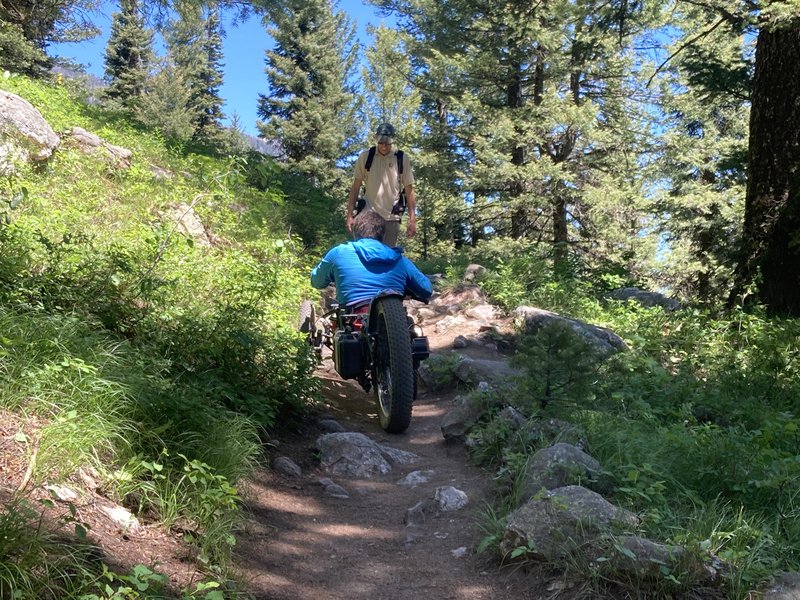
Joe Stone navigates boulders on a trail with his Bowhead Reach device in Grand Teton National Park. Photo courtesy of Quinn Brett
Before we head out to the Cub Lake trail, Brett takes me through the research she needs to do before a hike: combing the internet for trail photos and tidbits that might hint at how wide it is, how steep, and whether there are significant boulders or trees she won’t be able to get around. Do trail maps show bridges that might be too narrow for her handcycle? If the trail goes up a mountain, is it level enough that she won’t tip?
Someday soon, she hopes, this process won’t be necessary. An addition to the ABA from 2013 requires the display of certain information at every trailhead, including the trail’s length, average and minimum width, average and maximum slope and cross slope, and surface type. But a trail is exempt from compliance if it hasn’t changed recently—and most trails haven’t. Plus, as Brett puts it drolly, “our trails haven’t been measured probably since the beginning of time.”
She sees a solution in the HETAP (High Efficiency Trail Assessment Process), a single- or three-wheeled machine made by Nevada disability access firm Beneficial Designs. A user pushes the HETAP along a trail, stopping at least every 25 feet to capture data that include distance via a sensor in the wheel mechanism, location via GPS, and slope and cross slope from a built-in gyroscope. Obstacles like rocks or potholes can be entered manually or recorded with a camera. And that data can be sent out easily to create trail access information signs that cover all the information now required by law.
Todd Ackerman, the ADA assessment coordinator at Beneficial Designs, says sales of HETAPs—which cost $11,500 apiece—have been steady, as more parks and private land organizations look to provide trail information to users. In the past two years, his company has sold more than 25 HETAPs to land managers across the U.S. and Canada, and trained some 2,000 users from around the Americas and Europe. Here at Rocky Mountain, East Side Trail Supervisor Jesse Miller hopes to have all 355 miles of trails in the park assessed, and signs put in place, within five years.
Then, gone will be the days of rating a trail “easy,” “medium,” or “hard.” Brett, Miller, and the park service are mindful that trail difficulty depends on each user’s equipment and ability. One route might be “hard” because of its steep hills, which may be manageable on a handcycle but more challenging on a powerchair. Another might be “hard” because it’s full of narrow spots, which a slimmer chair could fit through but a handcycle or wider chair might get stuck on. A third might be dimpled with potholes and rocks, making it challenging for somebody with low vision or balance issues but fine for some devices with beefy tires. HETAP assessment can give visitors the information they need “so they can decide themselves” what trails they’re able to tackle, Brett says, “which is something people with disabilities have been saying forever.”
Digitizing and standardizing that information would also make it easy to create online resources for trail accessibility. Though a few such databases exist, so far there’s been nothing central. But Ackerman says many parks buying HETAPs put their information online as well as at trailheads. It’s a prospect that gives Brett hope. “Then I can just go to one place and look at it reliably, rather than cross-referencing three different websites,” she says. There are already so many layers of difficulty to interacting with the world as a person with a disability. “You just think, Can I have something that’s easy?”

A HETAP user rolls the single-wheeled device toward a switchback, collecting data that can ultimately be used for trail access information. Image courtesy of Beneficial Designs
We’ve fully left the Cub Lake trail, bushwhacking through dry grass to go around the stairs that gave Brett trouble, dodging elk droppings and bramble patches. She almost never does this, she says, but how else are we supposed to use this trail?
Many people who learn of Brett’s work at first think she’s advocating for paved trails in wilderness, not understanding that new devices like her Bombers don’t need pavement. “That’s not what we’re asking for,” Stone says. People like him and Brett want the challenges and obstacles that come with the rough backcountry.
That’s good, because no park could ever make all of its trails legally wheelchair accessible, Buzzell says, citing standards that require “firm and stable” surfaces and limit how steep trails can be. Some routes are hemmed in by cliffs and can’t be widened; some are studded with huge boulders that can’t be moved; some meander up mountains in a way that would be impractical without stairs of a certain height. “We might not be able to get a given trail to 100% of the legal definition,” he says. “But what if we could do it to 90%?”
Brett calls this lens of trail design “usability,” to differentiate it from the legal requirements of “accessibility.” There are a host of modifications that can make trails more usable, depending on context (city or wilderness), intended use (hiking, mountain biking, etc.), landscape, and other factors that make every route unique. So-called pinch points, where an obstacle creates a narrow spot, might be minimized and, if need be, earth could be humped around those obstacles to make them easier to roll over.
If the conditions are right, a trail might be designed with a cross slope steep enough that water runs off it but not so steep that it will cause tipping. If a trail has too high a cross slope, essentially sitting at a tilt, then it might be lined with what Brett calls “bumper rocks,” which function like bumpers at a bowling alley, keeping a mobility device and its user from tipping or slipping off a trail. Any steps might be rounded off instead of squared, constructed with pad lengths that help prevent handcycles like Brett’s from getting stuck on the climb up.
When Brett started training national park trail crews on usability, she wasn’t sure how they would react to taking on the extra work of implementing these kind of changes. But, it turns out, usability and sustainability often go hand and hand. Gentler slopes and cross slopes don’t just help hikers with disabilities—they prevent erosion. Wider trails aren’t just better for mobility devices—they also discourage able-bodied hikers from trampling vegetation on either side when they’re walking in a group. These design choices mean trails don’t have to be maintained as intensively. They’re like No, it’s less work,” Brett recalls of the trail crews. “It’s more upfront, but then we don’t have to come back for 15 years.”
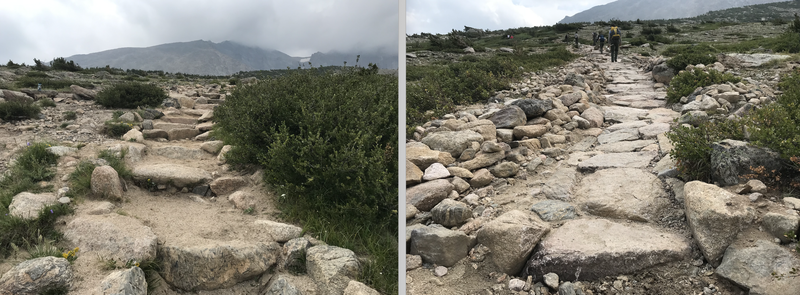
Trail crews converted stone stairs (left) to pavers (right) on a trail near Longs Peak in Rocky Mountain National Park. Pavers create a more sustainable and usable trail surface for hikers of all abilities. Images courtesy of the National Park Service
Brett and I finish bypassing the stairs and continue our hike, eventually turning around to head back to the parking lot. The ground is remarkably rocky and uneven, but Brett manages with no problem until the trail starts to tilt. Then, she asks me to stand at the edge of the path and hold her by the shoulder while pushing her wheel hard, so she can maneuver through the rough spot without tipping.
We get to the top of the previously problematic stairs—they’re much easier with gravity on Brett’s side—and pass a fellow hiker on her way up. She turns to watch Brett maneuver down the stairs. “I have never seen that before!” the hiker says, gaping.
“Yeah, I’m paralyzed,” Brett replies shortly.
This kind of interaction is typical, she tells me as we round the corner. “Mostly you get big, long stares and some kind of comment,” she says. At least this hiker didn’t say anything hostile. “It’s fatiguing as a human to have to do that with every person on a trail.” Recently, a man stopped to scold her: “Just so you know, this is one of the trails that isn’t for bikes.”
“Just so you know, this is my bike and my hiking machine,” she shot back. “My legs don’t work.”
Despite the frustration of these encounters, Brett is aware that her other goals can’t be accomplished without this most basic of changes: awareness that trikes are wheelchairs and wheelchairs are welcome. To that end, she and Stone spent several days in Grand Teton and Rocky Mountain national parks in summer 2021, rolling, zooming, and careening on trails with other adaptive hikers on a variety of devices, as well as with a local trail crew—the first of many such trips she hopes to take throughout the national parks. She says they were approached constantly by hikers exclaiming, “We didn’t know these things existed! My son, my daughter, my aunt, we could go hiking with them? Holy cow!”
Still, after one long day in Grand Teton, park rangers “got five or six phone calls saying people were biking on the trail,” Stone remembers. “People were seeing us and not wanting to say anything but calling and telling on us.” He hopes that, with time, this level of suspicion might decrease. “It would be nice at a certain point to be able to go out on trails and have people not think it’s amazing because it’s normal,” he says, “and not get mad that we’re out there because they’ve seen it enough that it’s normal. To have it be a non-event.”

Peter Axelson, who developed the High Efficiency Trail Assessment Process (HETAP), on the trail in his Cobra off-road wheelchair at Mount Washburn in Yellowstone National Park. Image courtesy of Beneficial Designs
As we make our way back through the meadow and across the rushing river, Brett points out that working on usable trail design is really about acknowledging that every trail is a built environment created via a series of choices, from a trail’s designated use to the best way to maintain it. The park service makes much of its dual missions, she says, preserving the nature under its care and making it available to the public. “What is that balance?” she asks. “Who decides, the horses are okay; this pit toilet is okay from time to time; sometimes for rescue we can fly helicopters, but never for anything else?”
It’s a topic Stone also feels strongly about. “It was okay to build this trail for you to walk on,” he says. “We can scar the land for all the walkers in the world, but we can’t scar it a little differently so everyone has access?”
Ultimately, the trips the two of them took in Grand Teton and Rocky Mountain weren’t just about building awareness. They spent several days hiking on different types of terrain with the parks’ trail crews, doing hands-on training. “We were showing them the bumper rocks; showing them widthwise what we needed,” Brett says. “And then having them make the trail, right there.”
Buzzell says some of the resistance to Brett’s work from within the park service has been concern about mobility devices causing damage to the environment. Aware of this dynamic, Stone felt self-conscious at first as he hiked with the trail crew. “Sometimes my wheel would spin out, and it might make a little black mark on a rock or kick up a little dirt,” he remembers. He worried that he’d give the trail workers a bad impression. But when he apologized, they brushed it aside, telling him, “We see way worse from foot traffic and way worse from horses.”
For Miller, those hikes were an opportunity to learn firsthand the effects of the design principles he’d learned from Brett. “I thought we’d have to clear every single rock out of here, but it turns out that’s not an issue,” he says. Instead, he realized he had underestimated the importance of a seemingly small detail: stair pad length. Most years, there’s a project somewhere in Rocky Mountain that includes the building of stairs. If the pad length is at all flexible, why not make sure it’s the most usable length? “That’s a simple shift,” he says.
During one of the last days of the trip, Stone remembers, he asked the trail crew, “How realistic is it to make this trail work for our equipment?” Perhaps some part of him expected to hear that it would be too big an undertaking. But rocks that don’t require blasting can be chiseled away; cross slope can be adjusted. “Actually, it’s pretty easy,” they told him. “We could have this trail totally done in three months.”
“They were all so nonchalant,” he says. “And I realized, ‘Wow, so it’s easier than I thought.”
 Source PBS Nova WGBH Educational Foundation
Source PBS Nova WGBH Educational Foundation
Also see
A Climb for Greater Accessibility REI
Looping the Olympic Peninsula New Mobility

